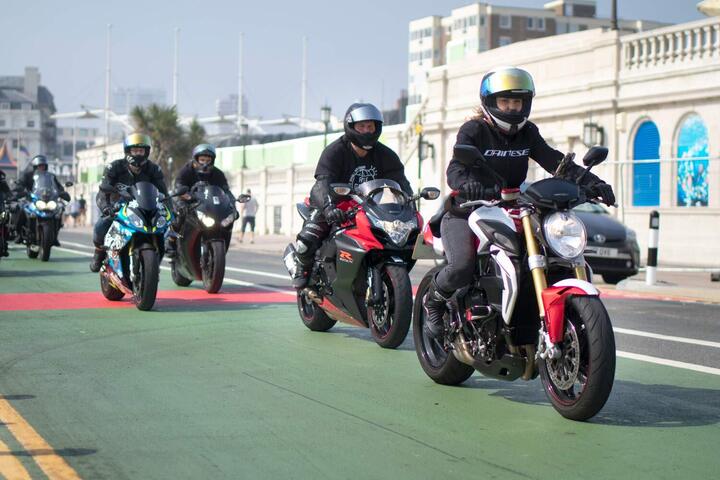On the buses...Motorcycles allowed in bus lanes
DfT guidance seems favourable to motorcyclists!
Lucy England
Recently, on January 15th 2024, the government Department for Transport issued up to date guidance on motorcyclists using bus lanes. Astonishingly it seems quite favourable to motorcyclists.
The latest guidance basically says that each local authority is allowed to let motorcyclists use the bus lanes in their area at their discretion. They first need to weigh up all the considerations and decide if they believe it to be helpful to both motorcyclists and general traffic flow in the given area.
The DfT actually advises that, where it is safe and practical to do so, local councils should allow motorcycles to use the bus lanes. It offers guidance on the things to consider when making their decision about bus lane use, and how to implement it with the necessary signage.
Motorcyclists in the bus lanes was first trialled in the 1990s and the trial areas were monitored to see what the effects were. Then advice was issued on this in 2007 and the range of benefits was deemed to be quite extensive. The list of the benefits of motorcycle bus lane use is quite encouraging. Motorcycles:
Offer a cheaper alternative mode of transport to the car
Provide independence and mobility
Enable more employment opportunities in areas where public transport may be limited
Speed up journey times where there is a lot of traffic and motorcycles and scooters can filter or use the bus lanes
Reduce total traffic congestion, as motorcycles take up less road space and can move through gaps when there is heavy traffic
May be seen as a genuinely practical choice for getting about faster in high traffic areas
Go With The Flow
The decision to allow motorcycles to use with-flow bus lanes (i.e. bus lanes which go in the same direction as the traffic but just alongside the road) is one to be carefully considered by each local authority individually, as conditions may vary in each area. In some places it may be safe and others not so much.
The government have given local authorities autonomy on deciding whether to allow powered two wheelers (motorcycles, scooters and mopeds – not e-scooters) in the bus lanes, as each area varies a lot and what may be appropriate in one area, it may not be ok in another. The volume of traffic varies everywhere and local authorities are best placed to make the decision themselves, with all the available data to hand.
Possible Hazards
One of the hazards of allowing motorcycles in the bus lanes is that the motorcycle may be vulnerable where the bus lane rejoins the main road. Where the bus lane ends – sometimes coming up to a junction for example, cars are cutting back in to what was the bus lane, but is now a lane for all traffic and they may not factor in the prospect of a motorcycle in the bus lane. This could open up the possibility of SMIDSY (sorry mate I didn’t see you) incidents, with cars not seeing motorcyclists because they are not expecting them. This may be a good area to put a sign up to look out for bikes to remind drivers of the possibility of the presence of a motorcycle in the lane, not just a bus.
Motorcyclists in some areas might make bus journey times slower by holding the bus up
Government advice is that bus lane usage should be consistent, i.e. if a bus lane is being used by motorcyclists it should be the whole bus lane, rather than intermittent bits of it. Intermittent changes could lead to confusion, where motorcyclists don’t know whether they are allowed in a particular stretch of bus lane or not.
It is really incumbent upon local authorities to communicate with each other, where a bus lane crosses from one local authority to another, in order to keep the bus lane rules consistent.
Turning Time
Turning at a junction is always one of the higher risk times for traffic and pedestrians. Local authorities need to stay on top of collision records to see what types of collision are recorded and what the causes might be. This will enable them to make the necessary decisions about motorcyclists in the bus lanes.
If there is a situation where motorcyclists regularly need to cross a bus lane to access a junction, then allowing the motorcycle to use the whole bus lane, may reduce the risk at this kind of junction.
These junctions should be considered particularly carefully for motorcycle safety. If traffic is turning across the path of motorcycles in the bus lane, appropriate measures should be taken to mitigate the danger. These could be things like moving a bus stop past a junction, or banning turning at that point.
Wide Boy
Another consideration needs to be the width of the bus lane. For optimum safety bus lanes need to be wide enough for bicycles and motorcycles to overtake the bus, at bus stops for example, without moving into the general traffic lane where they could cause a hazard.
Bus stop laybys can also be a hazard when the bus driver pulls out into the bus lane and may not have seen a motorcyclist or cycle coming along in the bus lane.
Despite some hazards, this would all generally appear to be good news for motorcyclists. The bus lane trial has been running for quite a few years now and the results are clearly favourable for councils, motorcyclists and traffic flow in general. Well we could have told them that, but at least the trend is positive.
Do you regularly use a bus lane when you are out? Do you find it helpful and are the signs clear enough? Have your say - let us know what you think on Facebook.
